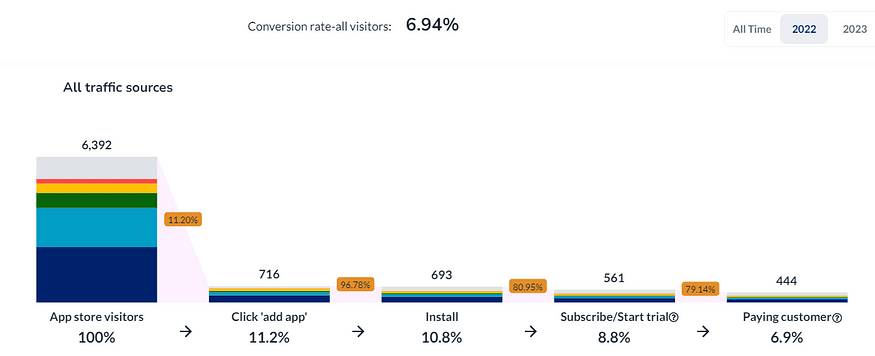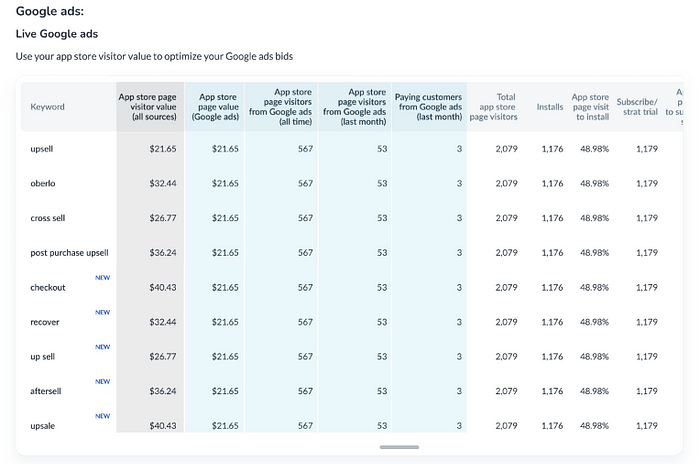Effective strategies for growing Shopify apps are constantly evolving. Techniques that boosted Shopify app growth last year may not work this year, and some of what’s possible this year was not possible last year. Savvy app developers know they must stay on top of the latest best practices to drive Shopify app growth in this dynamic and competitive ecosystem.
My name is Boaz Lantsman. I help dozens of Shopify apps grow through my Shopify app growth agency, Convert2x. Shopify app developers are generally smart, creative people. They try things. Some of them work. I help them improve in some aspects and learn from what they already do that works in others. We can always measure what’s working through the Shopify app growth platform I’ve co-founded, Prys.
My exposure to some of the most sophisticated and successful apps in the Shopify ecosystem, insider knowledge of their actions, and ability to measure results puts me in a unique position to know what drives growth for Shopify apps.
I will share all I know about effectively growing Shopify apps in 2025. Don’t go anywhere.
The Three Pillars of Shopify App Growth
To grow your app, you need to focus on the three key pillars of Shopify app growth: Traffic, Conversion, and Monetization.

1. Grow Traffic
Know your best keywords. Grow organic and paid search traffic. Develop other effective marketing tactics.
2. Optimize Conversion
Optimize your Shopify app card, app store page, and post-install funnel for conversion.
3. Maximize Monetization
Price, present your pricing, and monetize optimally for maximum ARPU and revenues.
This article covers the first part: Effective ways of growing your Shopify app traffic in 2025.
I’ll soon publish parts 2 and 3 — Conversion and Monetization best practices for 2025. Follow me on Medium or connect with me on LinkedIn to get notified as soon as they’re out.
How to Grow Shopify App Traffic in 2025
To scale your Shopify app effectively, it’s essential to grow top-of-funnel traffic. Focus on the following areas:
- Identify and prioritize the best traffic sources and keywords.
- Optimize your app store page for SEO.
- Scale performance marketing profitably.
- Expand other controllable traffic sources.
1. Identify Top Traffic Sources and Keywords for Shopify App Growth
Focusing on the best traffic sources and keywords is essential for achieving scalable Shopify app growth. Evaluate each source — whether blogs, partners, or ads — based on its contribution to conversions and revenue.
Prys provides end-to-end funnel tracking, enabling you to see installs, subscribers, and revenue for each keyword and marketing campaign. This data lets you prioritize high-value campaigns and keywords, focusing on those that best contribute to Shopify app growth.
Search volumes are also critical for your keyword strategy. Your #1 keyword may have as many searches as the rest of your top 10 combined. You can see search volumes by checking the impressions/visibility for top keywords in Shopify ads (valid only for [Exact] keywords, not broad).

2. Optimize Your App Store Page for Shopify SEO
The placement of an app store page in the Shopify app store organic search results is influenced by various factors, including the relevance of the app’s title, description, and keywords to the user’s search query, the number and quality of user reviews, and ratings — particularly recent ones, the app’s installation rates, “Built for Shopify” badge, the frequency of updates and improvements, and the overall engagement and user experience provided by the app.
You can easily boost your organic traffic for relevant search terms by placing strategic keywords in your app store page listing and related places. The more prominently a keyword is placed, the higher you’ll rank for it in Shopify’s organic app store search results and the more traffic you’ll get.
There are only so many prominent places to insert keywords in your app store listing. It’s critical to prioritize. You want to focus on the most valuable keywords for your app.
Once you have a prioritized list of keywords, you can place them strategically in your app store listing, growing the organic traffic you get from related searches.
Keyword-Related Tactics to Grow Organic Traffic:
- List your top 5 keywords in your Shopify Partners admin
- Weave your top keywords into your app store page’s title tag and meta description
- Your app name allows for 30 characters of top SEO real estate. Combine your app’s name with a top keyword or two.
- Your app card subtitle is another max 62-character blurb where you can use your top keywords to gain SEO points.

5. Your app URL is another place where you can add a keyword after your app’s name. For example https://apps.shopify.com/avada-email-marketing
6. App introduction is the prominent copy section below your video. You get 100 characters, 20–25 words, for your app’s value proposition. That gives you enough room for several top keywords.
7. Use your general copy and bullets to write your top keywords. Some repetition is ok.
By prioritizing high-value keywords across your app listing, you can attract more organic traffic and fuel Shopify app growth.
3. Scale performance marketing profitably
Performance marketing is a powerful way to drive targeted traffic and scale Shopify app growth. By optimizing campaigns on Shopify and Google Ads, you can reach a larger audience and increase app visibility.
Shopify Ads Optimization
Begin with 15–20 high-value keywords on Shopify and Google Ads. Use a mix of broad and exact match keywords: broad match helps uncover new terms, while exact match targets specific, high-converting keywords. Regularly review search terms, moving effective keywords to exact match and adding ineffective ones to a negative keyword list.
With Prys you can discover additional keywords that drive growth for your Shopify app, resulting in more installs at a lower cost per install.

Google Ads Optimization
Many top-performing Shopify apps use Google ads to boost traffic. Ads can lead to your app store page or a landing page outside Shopify, though app store pages typically yield higher conversions. There are two reasons to send to a landing page: You have monetization outside of Shopify, or the keyword is too competitive for sending to the app store page.
Shopify prohibits merchants from bidding on and using the ‘Shopify’ brand in the ad copy. There are several workarounds:
- Ignore, until you get a warning letter from Shopify. It may never come.
- Run Google ads to your landing page. Shopify has less leverage on that.
- Don’t bid or use “Shopify”. Use an extensive negative keyword list covering other e-commerce platforms. That way, you are left with only Shopify searches without bidding for the word “Shopify”. We created a negative keyword list of e-commerce platforms you may use.
- Don’t bid or use “Shopify”. Use the above negative keyword list alongside dynamic ad copy in your ads. Dynamic ad copy inserts the user’s search query automatically into the ad copy. For example, when the search is for “best Shopify apps” your copy will show “best Shopify apps” automatically, without your control.
- Use one of Google ads automated campaigns. Automated campaigns may use Shopify in the ad copy, but it’s the algorithm. You have no control over it.
Google ads automated campaigns
Google ads offers several automated campaigns. Based on recent research on ~15K Google ads accounts, by Optmyzr, a PPC management platform, Maximize Conversion Value and Target ROAS (Return On Ad Spend) automated campaigns vastly outperform manual PPC and other campaign types in terms of ROI.

Google’s advanced machine learning algorithms use deep-funnel events such as app install, subscription, and payment data for Smart Bidding. Smart Bidding is required to run high-performance Maximize conversion value or Target ROAS (Return On Advertising Spend = ROI) campaigns.
Because Prys’s technology is based on user journey attribution from app store visits to paying customers, Prys can send Shopify Install, subscribe, and payment events, their GCLIDs (Google’s ad click identifier), and the event values to Google ads, enabling Smart Bidding and high-performance automated campaigns. These campaigns can use your Shopify app store page as the landing page.
Sending deep-funnel event actions & values to Google can be the most effective way to grow your app profitably with Google ads.
Other performance marketing opportunities
Once your Shopify and Google ads are stable test other performance marketing platforms such as LinkedIn, Facebook, Bing, Reddit, Pinterest, YouTube, Instagram, TikTok, and Twitter. You can track performance by using Prys.
Three-month performance marketing plan
M1: Launch Shopify and Google ads for your top 15–20 keywords
M2: Check ROI, tune campaigns & add keywords. Set up conversion reporting and run a Maximize Conversion Value test campaign
M3: Tune campaigns & add keywords. Add, test, optimize, and expand other platforms: Facebook, LinkedIn, TikTok, Instagram, Bing, etc.
4. Expand other sources you control
There are many effective ways to market Shopify apps beyond search marketing. Different tactics work for different apps. Try the tactics that you believe may work. Make sure you can measure if they do.
If you’ve been doing marketing for some time, you’ve accumulated insightful data. Once you connect your app to Prys, you’ll see which Shopify app marketing tactics drive revenues and should be expanded.
6 Shopify app marketing tactics beyond search
- Cross-promotion with apps outside your category
- Cold outreach to your target customer profiles
- Content marketing to attract potential customers
- Affiliate marketing to expand your reach
- Influencer partnerships relevant to your audience
- Email marketing to convert trialists and free users
Summary and Key Takeaways to Grow Shopify Apps
Use these tactics to grow your top-of-funnel traffic and scale your app:
- Targeted Traffic Sources and Keywords: Use Prys and Shopify ads data to identify valuable keywords and sources, then monitor and adjust based on performance.
- SEO Optimization: Place keywords strategically throughout your app store listing for organic traffic growth.
- Profitable Performance Marketing: Focus on your top keywords in Shopify and Google ads. Test Maximize Conversion Value campaigns in Google ads and explore other platforms over time.
- Expand High-Converting Sources: Experiment with and scale non-search channels that drive significant revenue.
By implementing these Shopify app growth strategies, you can increase app store traffic and scale your business effectively in 2025.
Final words
Stay tuned for parts 2 and 3 on Conversion and Monetization strategies for Shopify app growth in 2025. Follow me on Medium or connect with me on LinkedIn for updates.
See you soon in the next article: Shopify App Conversion Optimization Best Practices for 2025.


































Recent Comments